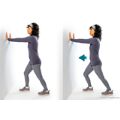Shin Splints
Condition Basics
What are shin splints?
Shin splints are a condition that causes pain and sometimes swelling in the front part of the lower leg (shin), Opens dialog. The pain is most likely from repeated stress on the shinbone (tibia) and the tissue that connects the muscle to the tibia.
What causes them?
Most people get shin splints from repeated pounding on hard surfaces during activities such as running, basketball, or tennis. You can also get them when you:
- Change to new running or workout shoes or wear shoes that don't have enough support. This can happen when you wear your shoes too long and they wear out.
- Run or walk on a different surface than you are used to. For example, you might get shin splints when you switch from running on a trail to concrete or asphalt.
- Work out harder than usual or train too hard or too fast instead of working up to a training level gradually.
Some people have flat arches in their feet, which can make the feet roll inward when running. This may also lead to shin splints.
What are the symptoms?
Most people with shin splints feel pain on the front lower part of the leg. Some people have mild swelling too.
When you first notice the pain, it may just be at the start of your workout and feel like a dull ache or soreness. If left untreated, the pain can become sharper and last until you stop exercising. In severe cases, the pain can continue even after you finish your workout.
How are they diagnosed?
Your doctor will be able to tell if you have shin splints by talking to you about your symptoms and examining you. The doctor may do an X-ray to rule out other conditions, such as a stress fracture, Opens dialog.
How are shin splints treated?
In many cases you can use home treatment to help relieve pain and swelling from shin splints.
- Rest is often the best treatment for shin splints. This doesn't mean that you have to stop exercising. The idea is that you can exercise as long as it isn't painful. You may need to avoid high-impact activities like running until you feel better, or at least cut back on how often and how long you run. As you recover, it may help if you:
- Choose low-impact activities such as swimming or cycling instead of, or in combination with, running.
- Run or exercise only on soft surfaces, such as dirt or grass.
- Run on level ground and avoid hills.
- Reduce your speed and distance when you run.
- Ice helps to reduce pain and swelling. Apply the ice or cold pack for 10 to 20 minutes, 3 or more times a day.
- Elevate your lower leg on pillows while you apply ice and anytime you sit or lie down. Try to keep your lower leg at or above the level of your heart to help minimize swelling.
- Stretching exercises, such as those that stretch the calf, Opens dialog, may also help.
- Get a new pair of shoes. Pick shoes with good arch support and a cushioned sole. Or try shoe inserts (orthotics). Use them in both shoes, even if only one leg hurts.
Ask your doctor if you can take over-the-counter medicine. For example, ibuprofen (such as Advil or Motrin) or naproxen (such as Aleve) can help relieve pain and swelling. Acetaminophen (such as Tylenol) helps with pain. Be safe with medicines. Read and follow all instructions on the label.
Ask your doctor if strengthening and range-of-motion, Opens dialog exercises are right for you.
After you feel better, don't go back to your old exercise routine too quickly. Start slowly, and little by little increase how often and how long you work out. If you start out too fast, your pain may come back.
How can you prevent them?
There are things you can do to help prevent shin splints.
- Start slowly when you try a new activity. For example, if you are new to running, increase the distance and pace of your run over several weeks.
- Wear shoes that fit your foot right. And don't work out in shoes that are worn out.
- If you have flat feet, you may try a shoe insert to give you more support and cushion the impact of exercising on hard surfaces.
- If you are a runner, try cross-training with a low-impact sport, such as swimming or cycling.
Current as of: July 31, 2024
Author: Ignite Healthwise, LLC Staff
Clinical Review Board
All Healthwise education is reviewed by a team that includes physicians, nurses, advanced practitioners, registered dieticians, and other healthcare professionals.
Current as of: July 31, 2024
Author: Ignite Healthwise, LLC Staff
Clinical Review Board
All Healthwise education is reviewed by a team that includes physicians, nurses, advanced practitioners, registered dieticians, and other healthcare professionals.
This information does not replace the advice of a doctor. Ignite Healthwise, LLC, disclaims any warranty or liability for your use of this information. Your use of this information means that you agree to the Terms of Use. Learn how we develop our content.




